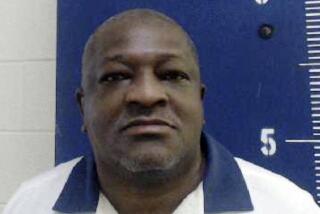Inmate says he’s too obese for execution; victim’s son not swayed
- Share via
Lawyers for an obese prisoner on Ohio’s death row say their client should be spared in part because of his weight, which they say could cause “severe complications” if executioners try to give him a lethal intravenous injection.
The argument, reported Monday by the Cleveland Plain Dealer, drew scoffs from the family of Ronald Post’s victim, Helen Vantz. Post was convicted in the 1983 shooting death of Vantz, who worked as a desk clerk at an Ohio hotel.
“I don’t care if they have to wheel him in on a tractor-trailer; 30 years is too long,” William Vantz, the victim’s son, told the Plain Dealer. “Enough is enough. This is just an excuse to get out of the execution.”
Post, 53, who is 6 feet 3 and weighs about 480 pounds, is due to be executed Jan. 16. His lawyers say his weight is just one of the reasons the execution, which in Ohio is performed by lethal injection, should be stopped. They also argued in court papers that they need time to investigate whether claims that Post confessed to other inmates were exaggerated.
But it is the weight argument that has drawn attention to the case. In court papers, his attorneys, Joseph Wilhelm and Rachel Troutman, said Post’s myriad weight-related medical problems made it likely that a lethal injection would involve “a torturous and lingering death.”
They also noted that Post has tried repeatedly to lose weight but that life in prison has made that difficult. His request for gastric bypass surgery was turned down as “not medically necessary,” and the exercise bicycle he was using daily “broke under his weight,” they said.
Whatever the arguments, precedent does not appear to be on Post’s side. In 2008, Richard Wade Cooey II was executed in Ohio after lawyers cited his size -- he was 5 feet 7 and weighed 270 pounds -- as a reason for halting the execution. As with Post, they said Cooey’s body fat would make it too difficult to find a vein for the lethal injection.
Cooey had been convicted in the 1986 rape and murder of two university students. Prison officials said his execution went smoothly, and news reports at the time said it took eight minutes from the first shot, which put Cooey to sleep, until he was pronounced dead.
Things did not go so smoothly for another obese Ohio inmate, Christopher Newton, who was executed in May 2007. Executioners had problems finding a suitable vein for the IV, and his execution went on for about two hours -- requiring a bathroom break for the condemned man.
According to an Associated Press timeline of the execution, the prison spokesman held up a sign for reporters witnessing the execution effort which read in part: “His size is creating a problem.”
ALSO:
Teens who ‘sext’ more likely to have sex, study suggests
Nevada recluse dies with $200 in bank, $7 million in gold at home
Penn State’s Jerry Sandusky to be sentenced October 9 for child abuse
More to Read
Sign up for Essential California
The most important California stories and recommendations in your inbox every morning.
You may occasionally receive promotional content from the Los Angeles Times.











